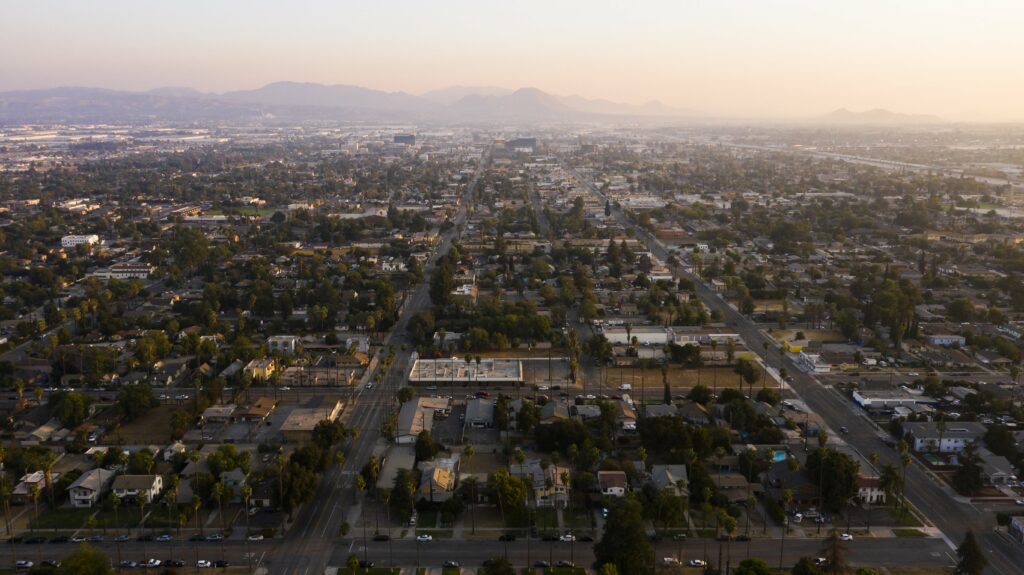Housing Disinvestment
Land in the Inland Region has been swallowed rapidly by commercial housing development and warehousing. Since the 2010 recession, over 150 million square feet (about 3,300 football fields) of industrial space, mostly warehouses, has been built in the Inland Empire, according to real estate services company CBRE. Meanwhile, despite the booms and busts of the foreclosure crisis and subsequent economic instability, tract housing has advanced far into both agricultural land and natural resources.
The Fund For Inclusive Califronia’s Funding Housing Justice For Thriving Communities research has shown that even as housing stock has grown, discrimination in housing access persists, housing stock quality is problematic, and evictions hit working-class households hard. The portrayal of the region as a cheap alternative to Los Angeles has meant that real estate companies and landlords have taken advantage to actually push market prices higher. In communities like Victorville, where there is increased growth, background checks and other mechanisms are used to block formerly incarcerated people from obtaining much needed homes.
Infrastructure and public resources do not also necessarily accompany growth. In San Bernardino, organizations report more vacant lots than occupied buildings - some 2345 vacant lots by some estimates. The city leadership has so far failed to hear organizer’s ideas for an agricultural incentivized zone, a policy that allows zoning to accommodate community gardens and urban farms.
Transforming these histories is the work of Time for Change Foundation and others, working on creating housing owned and managed by formerly-incarcerated women and other hard-hit communities. As one organizer shared, “Instead of just fighting for Section 8 Vouchers that perpetuate poverty [through draining rental structures, we are focusing on owning land, becoming builders of wealth - this is how we reconnect with land and liberate ourselves.”
Reclaiming and Remaking Mobile Homes
Mobile home parks have also been the site of affordable and safe housing crises and new kinds of organizing. The Oasis Mobile Home in Eastern Coachella Valley is one of the larger mobile home parks, with 220 trailers housing about 1,900 people, majority-Latinx and Purépecha community, on Torres Martinez Reservation land. Residents of Oasis experience inadequate housing infrastructure, drinking water high amounts of arsenic, sewage pools near homes and improperly treated wastewater that further contaminates drinking water, and water and power outages, most frequently in the summer months. Despite intimidation, threats, and price gouging, residents have come together over the years to speak up regarding conditions and demand solutions.
At same time, as a strategy in this land afflicted by displacement, families have created locally-owned mobile home parks of up to 12 units, known as polancos. Many built mobile homes without permits because they didn’t know how to get them, seeking grassroots affordable housing opportunities. Some Inland cities have evicted these makeshift parks, and pushed mobile homes into tribal lands that are already taxed and needing infrastructure. One member of the local area shared, “this unique community took matters into their own hands - they are not bad actors willfully neglecting tenants, and they need technical assistance. No program has supported mobile home/polanco communities, or seen them as affordable housing projects.” Polancos exemplify the layers of issues residents deal with, including their desires to have sovereignty over their housing while being facing obstructions from local officials who do not listen to their perspectives and dealing with long-term disinvestment in infrastructure.
Environmental Justice
Environmental degradation in the region is severe and dangerous due to the climate and geography, logistics and shipping industries, and lack of adequate public services. The Inland Region has long had notoriously poor air quality because natural air currents bring gaseous pollutants and particulate matter from the Los Angeles area while the warehousing and logistics boom has potentially increased emissions from diesel trucks and trains. In fact, Riverside ranks 93 percentile in pollution burden as measured by the CalEnviroScreen. Community organizers have identified the connections between the local air and water quality and environmental racism and corporate interests, and have mobilized in response. This provides a robust framework for which philanthropy can further understand the Inland Region’s environment, both the organizing landscape and the land itself.
Transportation
In the Inland Region, public transportation is inadequate to serve the community's needs and as a result is underutilized. The Southern California Association of Government’s region profile from 2019 shows that only 1% of those in Riverside and 2% of those in San Bernardino that are commuters actually use public transportation. Public transportation provides community access to movement and is an important piece of the puzzle in creating environments where communities can thrive. It also connects to community autonomy and ability to participate in climate justice, as walking, biking, and using transit reduces greenhouse gas and the lack of public transportation inhibits that ability.
Toxic Air
One of the main environmental concerns is air pollution, the presence of harmful or toxic pollutants in the air, most of which come from energy production and use. Air quality in the Inland Region is adversely impacted due to both geography and the logistics and shipping industries. Air pollution already exists from the same dynamic experienced in Los Angeles - lots of sun and surrounding mountains means that air pollution gets trapped near the ground by these surrounding mountains and a layer of warm air in the atmosphere called an inversion layer. Traffic, which has increased significantly as a result of the logistics and shipping industries, is a significant source of air pollution - the average percentile for traffic across census tracts with warehouses is 67% compared to the state average of 50%. In addition to traffic, warehouses themselves contribute to environmental pollution. There are more than 3,000 large warehouses (over 100,000 sq ft) in southern California, and they are concentrated in areas that rank in the highest percentile for toxic emissions in the state (worse than 86% of the state’s census tracts).
The impact of poor air quality is dire and manifests itself quite concretely. In 2018, the city of San Bernardino experienced 102 bad air days for ozone pollution, meaning nearly a third of the year was spent in an unsafe environmental state, just based on air quality alone. This air pollution adversely impacts the health of communities, from short-term respiratory illness to long-term effects. This is especially dangerous during a pandemic: one nationwide study showed that just a small increase in fine particulate matter (PM2.5), was associated with an 11% increase in the COVID-19 death rate for U.S. counties.
Water
Water pollution is yet another indicator of environmental neglect in the Inland Region, particularly in the Coachella Valley, where there are issues with drinking water, sanitation, and wastewater as a result of poor water infrastructure. In polanco communities in the Eastern Coachella Valley, arsenic is present in drinking water, and in fact some mobile home parks have onsite wells that are 90 parts per billion (maximum RCA levels are 10 parts per billion) - an issue that goes unaddressed by government infrastructure services. Communities often have to rely on inconsistent water deliveries, or utilizing their own resources to purchase bottled water.
Wastewater is also a severe issue in Eastern Coachella Valley, due to poor wastewater infrastructure. Wastewater pipes leak into the soil and drinking water pipes will pull in those contaminants from the wastewater into the drinking water, making the drinking water contaminated. These pipes also leak, allowing untreated water into the ground. Additionally, there are straight pipes, meaning that the pipe comes out of the residential unit without any water treatment. These issues pose significant health risks, infectious diseases, and overall degrades and challenges the immune system, even potentially impacting overall cognitive development.
Despite this, organizers are finding ways to get their communities safer water with minimal capital and investment. Pueblo Unido CDC, an affordable housing initiative, identified the need for community-led solutions and found a technology that could address this issue - a reverse osmosis filtration system called Short Term Arsenic Treatment program (STAT) that is a cost effective, interim solution to address water contamination at mobile home parks. Many homes may not be able to consolidate with municipal services due to more remote locations, and will have to rely on decentralized systems like reverse osmosis filtration, septic systems, and some other form of stone water control.

